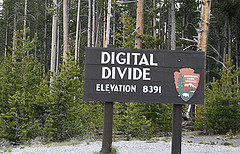This is part 2 of the Hindsight 20/20 series. Part 1, “Your choice of social platform does matter”, is here. This month’s post discusses the inevitable clash of cultures between the s0-called digital natives and digital immigrants when rolling out a social business platform in a large organization, and how to approach it.
Once the social business platform becomes available to all – or most – employees in your organization, you’ll soon find that the “build and they will come” strategy won’t work this time around. Many will come – early adopters and folks familiar with Facebook and Twitter – but many others will not. Some will not just ignore it – they will abhor it, roll their eyes publicly or in private conversations, and just hope that the social business fad will pass soon. You may be tempted to just ignore the latter group – after all, if tens of thousands of users are adopting “the new way”, why bother with the naysayers? This is a 90-9-1 adoption world anyway, isn’t it? Facebook seems to be doing OK with their one billion users, despite having five or six billion people not adopting it yet. Well, it turns out that this is one of the fundamental differences between the consumer and enterprise models of social technology adoption: while consumer social platforms simply seek enough of a critical mass to achieve a sustainable revenue stream, in the corporate world you just can’t afford leaving people behind. This post covers the multiple facets of the online social divide at the workplace.
Much has been said and written about the digital divide, “an economic inequality between groups, broadly construed, in terms of access to, use of, or knowledge of information and communication technologies.” Most often, it refers to the gap between the “haves” and the “have-nots”, attributed to social, economic, cultural, or age discrepancies. Over the last quarter of a century, knowledge workers around the world overcame the digital literacy barrier, and are proficient in using a computer for at least the most basic functions: email, calendar, word processing, and web browsing. It’s almost inconceivable today to imagine a team of cubicle warriors where some members don’t know how to use any of those digital vehicles. On the other side, in our personal lives we interact with hundreds of people who never mastered any of those, and who live happily without them.
As the Internet became more social, and, for the lack of a better term, “networked”, it added a new level of sophistication to its frequent users. Those who can “speak” the language of Google, Twitter, Facebook, Netflix, gaming, and mobile apps can get so much more out of it than users who just know the basics. The advent of social business platforms brought that sophistication to the workplace, and “social” may eventually become as necessary for regular office work as email is. But, to realize the full value of that transformation, it’s imperative that the vast majority of your c0-workers adopt the new platform. Email would never have worked if only half of your employees bothered embracing it.
But make no mistake. This digital divide needs to be understood and addressed from multiple perspectives. During the Renaissance, Michel de Montaigne wrote in his famous essay Des Cannibales: “We simply call barbarous those customs that are different from our own; it seems indeed that in our search for truth and reason we cannot see beyond the ideas and conventions of our own country.” He was, of course, talking about the labeling of cannibal natives in the New World, but the described pattern applies to cultural relativism as well. Digital natives may naïvely assume that they’ve got the best half of the digital divide. However, for all their “new tech” savvy, many may lack other key skills that came naturally with the “old tech”- the discipline, thoroughness and sound judgment to create and assess authoritative content, the justified concerns about privacy and security, and the hard-earned experience of understanding the non-technical side of the workplace.
Furthermore, there is more than a generational divide in play here. Senior executives may be digitally savvy in the consumer Internet, but reluctant to use a similar online social networking platform at work, as the dynamics of social business communications are so different from the peer-to-peer or broadcast nature of conventional office tools. There is also a compliance divide in some industries – notably financial services and government – separating regulated employees from the rest. Finally, external consultants, contractors and off-shore staff may have limited access to the platform compared to on-shore full-time employees.
Thus, you shouldn’t ignore the non-adopters. On the contrary, make sure your implementation plan maps the groups still not active in your platform and includes plenty of mechanisms to bring them in and address their concerns: extensive classroom and remote training, one-on-ones for executives, conventional communication vehicles, Q&A sessions, lunch & learns, compliance education, alignment with corporate policies, and code of conduct. At the end of the day, both early adopters and laggards have the same objective in mind: the long term viability of the social contract between the organization and its workers.






